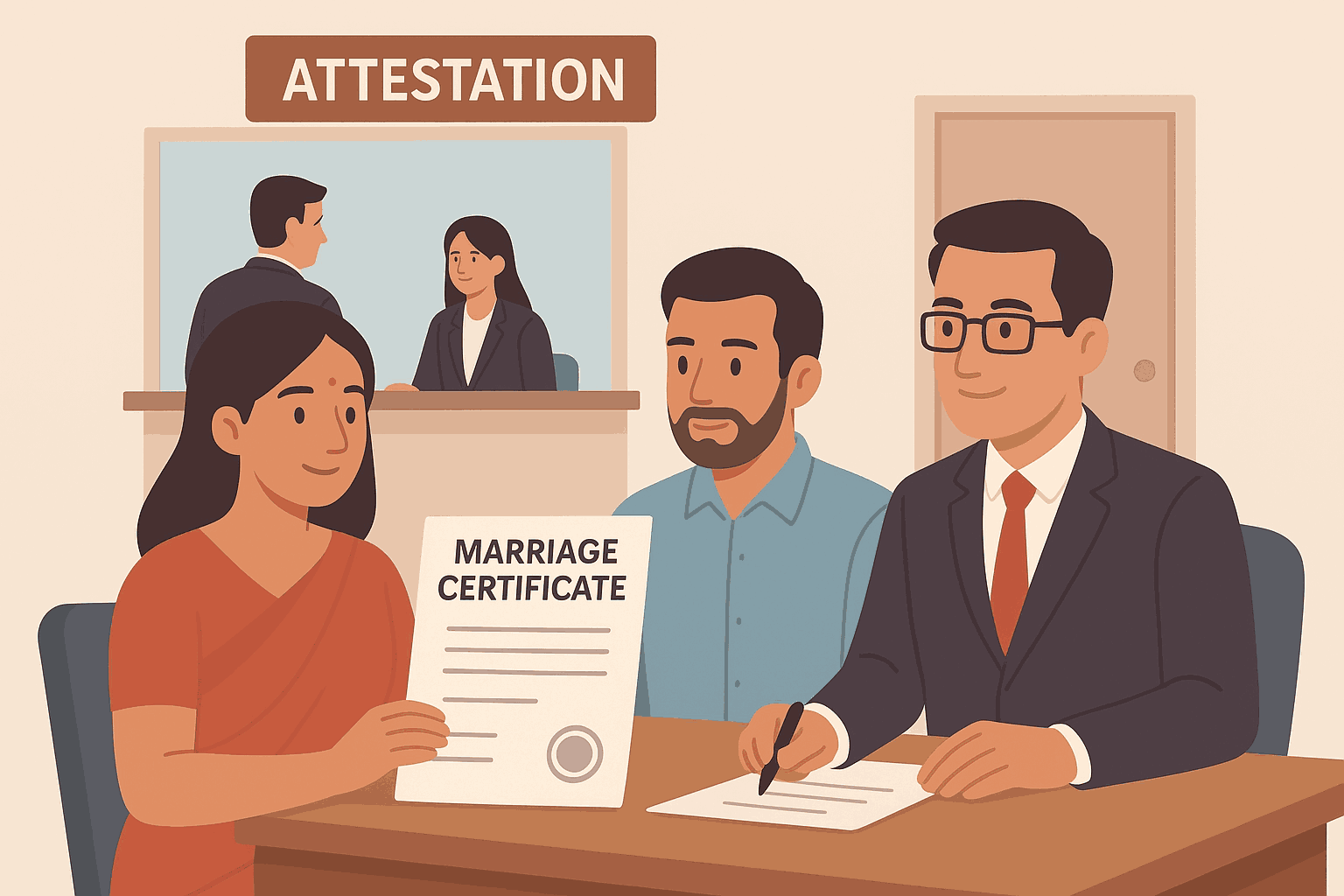
Marriage certificate attestation is an essential process for anyone planning to move abroad with their spouse or to prove the legality of their marriage in a foreign country. It’s a formal procedure that verifies the authenticity of the marriage certificate and ensures that it is recognized by authorities outside the home country. While the process might seem straightforward, many people encounter complications due to simple mistakes that could easily be avoided with proper understanding and preparation. This article will explore the most common mistakes made during marriage certificate attestation, the implications of these errors, and practical ways to avoid them.
Understanding Marriage Certificate Attestation
Before delving into the common mistakes, it’s important to understand what marriage certificate attestation actually involves. Attestation is the process of authenticating a document by a series of authorities to make it legally acceptable in another country. When it comes to a marriage certificate, the attestation confirms that the marriage was legally registered and the document is genuine.
The process typically includes several stages:
-
Notary Attestation: The document is first verified by a local notary public.
-
Home Department or State Authentication: The state home department or the Sub-Divisional Magistrate (SDM) verifies the document.
-
Ministry of External Affairs (MEA) Attestation: The MEA authenticates the document at the national level.
-
Embassy or Consulate Attestation: Finally, the respective foreign embassy or consulate verifies the attestation for use in their country.
Each step requires precision and compliance with specific requirements. Any oversight can lead to delays, rejections, or even the need to restart the entire process.
Mistake 1: Submitting an Illegible or Poorly Printed Certificate
One of the most frequent and easily avoidable mistakes is submitting a marriage certificate that is damaged, faded, or poorly printed. Foreign authorities are extremely particular about the clarity and readability of documents. A certificate with faded ink, torn edges, or unclear seals can be rejected outright.
To avoid this, always ensure that your certificate is in excellent condition. If it is an older document, request a fresh copy from the issuing authority before starting the attestation process. Always use high-quality photocopies for notarization if required, and make sure the seals and signatures are legible and intact.
Mistake 2: Attesting a Duplicate or Unofficial Copy
Another common error is submitting a photocopy or duplicate certificate instead of the original. Attestation authorities only verify original documents. A copy that hasn’t been certified as true or lacks official signatures will be deemed invalid.
Always begin the process with the original marriage certificate issued by the registrar. If the original has been misplaced, apply for a duplicate through official channels and ensure it bears the correct registration number, seal, and signature before starting the attestation process.
Mistake 3: Ignoring the Sequence of Attestation
The attestation process must follow a specific hierarchy, and skipping or altering the order can invalidate the attestation. Many applicants mistakenly approach the embassy or the MEA before obtaining verification from local or state authorities, which leads to rejection.
For instance, the MEA will not attest a document unless it has been authenticated by the respective state home department or SDM. Similarly, embassies will not proceed unless the MEA stamp is present. It is crucial to follow the sequence exactly: Notary → State/SDM → MEA → Embassy/Consulate.
Mistake 4: Submitting Incomplete Documentation
Each stage of attestation may require supporting documents such as a passport copy, visa, identity proof, or a covering letter. Applicants often fail to provide one or more of these documents, which results in unnecessary delays.
To prevent such issues, prepare a checklist before beginning the process. Verify the requirements for each attestation level since they may vary depending on the country of destination. Missing documents can cause rejections or compel you to restart the procedure, leading to additional costs and frustration.
Mistake 5: Not Verifying the Requirements of the Destination Country
Different countries have different attestation requirements. For instance, Gulf countries like the UAE, Qatar, or Saudi Arabia have specific procedures, while European countries might follow an Apostille convention instead of full embassy attestation. Many people assume the same process applies everywhere, which is not the case.
Before starting, research the destination country’s legalization requirements or consult a professional attestation service. Some countries require translation into their official language or demand additional authentication steps. Being unaware of these specific rules can result in your attested certificate being rejected abroad.
Mistake 6: Failing to Translate the Document Properly
If the destination country uses a different official language, translation might be necessary. However, an inaccurate or uncertified translation can render the entire document invalid. Some applicants attempt to save costs by using automated translation tools or unqualified translators, which often leads to errors in names, dates, or legal terms.
Always use a certified translator who can provide a legally recognized translation. In many cases, the translated document must also be notarized and attested along with the original. This ensures that both the translation and the original certificate hold legal validity abroad.
Mistake 7: Providing Incorrect Personal Information
A minor error in names, dates, or identification numbers can cause major setbacks. For example, if your name on the marriage certificate doesn’t exactly match the name on your passport or other documents, the authorities may reject it. These inconsistencies are often due to spelling mistakes, typographical errors, or changes after marriage.
Before submitting your certificate for attestation, carefully cross-check all personal information across your documents—names, dates of birth, and registration details must be consistent. If discrepancies exist, rectify them through the registrar’s office before beginning attestation.
Mistake 8: Ignoring the Validity of Stamps and Signatures
Each attestation stage involves official seals and signatures. If any of these are outdated or invalid, your document will not be accepted. For instance, a notary whose registration has expired cannot provide a valid attestation. Similarly, if the official’s signature differs from the one registered with higher authorities, your document might be rejected at later stages.
Always verify that the notary or signing authority is currently authorized. Working with reputed attestation agents or contacting the state home department directly can help ensure all stamps and signatures are legitimate.
Mistake 9: Delaying the Process Until the Last Minute
Many people begin the attestation process only after receiving a visa or foreign job offer. This can be risky because attestation takes time—anywhere from a few days to several weeks, depending on the country and level of verification required.
Delaying the process increases the chances of missing submission deadlines or travel schedules. To avoid such stress, start the attestation process as soon as you know you will need it. Having your attested documents ready in advance can make visa or immigration procedures much smoother.
Mistake 10: Choosing Unreliable or Unauthorized Agents
While professional attestation agencies can make the process easier, not all service providers are reliable. Some unauthorized agents offer low-cost services but use shortcuts, fake stamps, or incomplete verification, which can lead to serious legal consequences.
Always verify the credentials of the agency you’re dealing with. Look for reviews, official registration, and transparency in processing. A trusted agency will provide receipts, tracking options, and regular updates. It’s better to pay slightly more for genuine service than risk invalid documents or potential fraud.
Mistake 11: Not Keeping Track of Document Status
After submission, many applicants simply wait without following up. Unfortunately, delays or rejections can occur at any stage, and if you’re unaware, you might lose valuable time. It’s essential to track your document’s status regularly, either through the official channels or via your service provider.
Keep copies of all receipts, reference numbers, and communication emails. If you notice an unusual delay, contact the concerned office immediately. Timely follow-up helps you identify and resolve issues before they escalate.
Mistake 12: Overlooking Country-Specific Legalization Alternatives
Some applicants misunderstand the difference between attestation and apostille. Countries that are part of The Hague Apostille Convention (like the USA, UK, and most European nations) do not require embassy attestation. Instead, an apostille stamp from the MEA suffices.
Submitting documents for embassy attestation when only an apostille is required wastes time and money. Always verify whether your destination country follows the Apostille Convention. Understanding this distinction can simplify your process significantly.
Mistake 13: Ignoring Minor Differences in Formats and Seals
Different authorities may use slightly varied formats for marriage certificates. For example, older certificates may have manual entries, while newer ones are digitally printed. Some countries prefer computer-generated certificates with barcodes, while others still accept handwritten versions. Submitting a format not recognized internationally can cause rejections.
If your certificate is an older version, it’s advisable to obtain a modern reissue from the registrar. This ensures your document meets the current verification standards used by international authorities.
Mistake 14: Failing to Keep Copies of the Attested Documents
Once your marriage certificate has gone through multiple rounds of attestation, it’s a valuable document that can be difficult to replace. Many people make the mistake of not keeping properly scanned or photocopied versions of their attested certificate. If it’s lost or damaged, they must repeat the entire process.
To avoid this, always make multiple copies of the final attested certificate and store them securely, both physically and digitally. A certified digital copy may also be accepted in some cases, especially for visa applications.
Mistake 15: Overlooking the Need for Both Spouses’ Documents
Marriage certificate attestation often requires supporting identification documents from both spouses. Some applicants only provide one partner’s ID or passport, assuming it’s sufficient. However, embassies and consulates usually require verification of both individuals to confirm the legitimacy of the marriage.
Ensure that both passports and identity proofs are up-to-date and available in original form. Incomplete submission can delay or invalidate the attestation.
Mistake 16: Misunderstanding the Role of Attestation in Visa Processes
Many people mistakenly believe that attestation alone guarantees visa approval. While attestation is a necessary step, it is only one part of the broader documentation process. The embassy uses attested documents to verify authenticity, but approval depends on various other factors such as background checks, sponsor verification, and country-specific requirements.
Therefore, treat attestation as a supporting procedure rather than the final step in your relocation or visa process. Understanding its purpose helps manage expectations and ensures you prepare all other necessary documents accordingly.
Mistake 17: Neglecting to Check Document Expiry or Revalidation Requirements
In some countries, attestation is valid for a limited period—typically six months to a year. If you delay using your attested certificate, it may expire, requiring revalidation. This is especially true for countries with stringent immigration regulations like Saudi Arabia or Kuwait.
Always check the validity period of your attestation and plan accordingly. If you expect delays in your travel or visa process, keep track of when your document might need to be re-attested.
Mistake 18: Submitting Incorrect Application Forms or Payment Details
At various stages, you may need to fill out forms and pay attestation fees. Errors in these forms—such as incorrect application numbers, incomplete addresses, or mismatched signatures—can cause unnecessary complications. Similarly, payment issues such as incorrect fee amounts or missing receipts can delay processing.
Always double-check the official website or authority’s guidelines for updated form formats and fee structures. Retain payment receipts and include them with your submission to avoid disputes later.
Mistake 19: Using an Outdated Attestation Procedure
Government policies and embassy requirements are subject to change. What was valid last year might not apply today. Many applicants rely on outdated online articles or word-of-mouth information, leading to confusion.
Before beginning the process, always verify the latest attestation procedures through the official websites of the Ministry of External Affairs, state home departments, or the concerned embassy. Keeping up to date ensures you follow the correct steps and avoid rejection due to outdated practices.
Mistake 20: Underestimating the Importance of Professional Guidance
While some individuals successfully complete attestation on their own, many find it confusing and time-consuming. Without prior experience, it’s easy to make mistakes that cause delays or additional costs. Consulting an experienced attestation professional or legal advisor can make a significant difference.
Professional agents understand the nuances of documentation, country-specific requirements, and current regulations. Their expertise ensures that your certificate is processed correctly the first time, saving you effort and potential stress.
Conclusion
Marriage certificate attestation services is more than just a bureaucratic formality—it’s a critical process that legally validates your marital status in another country. Mistakes, even minor ones, can lead to rejection, delays, or legal complications that disrupt your travel, employment, or visa plans.
By understanding and avoiding common pitfalls—such as submitting incomplete documents, skipping steps, or using unreliable agents—you can ensure a smooth and efficient attestation process. Always keep your documents organized, verify requirements from official sources, and begin early to prevent last-minute hurdles.
Ultimately, patience, attention to detail, and proper guidance are key to successful marriage certificate attestation. With the right approach, you can navigate this essential legal procedure confidently and without unnecessary setbacks, ensuring that your marriage is recognized and respected wherever life takes you.




